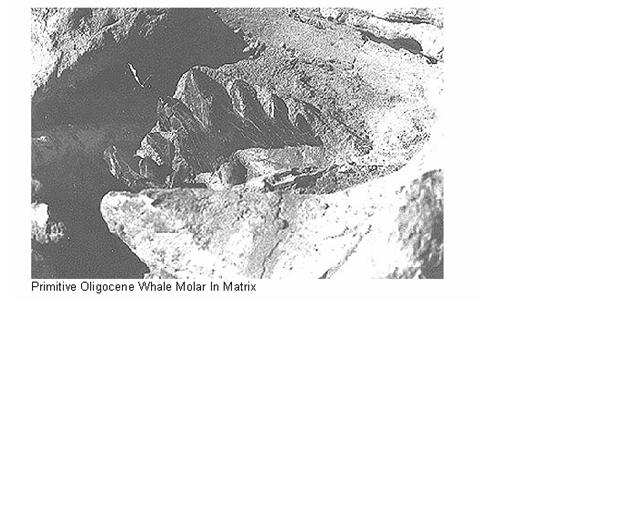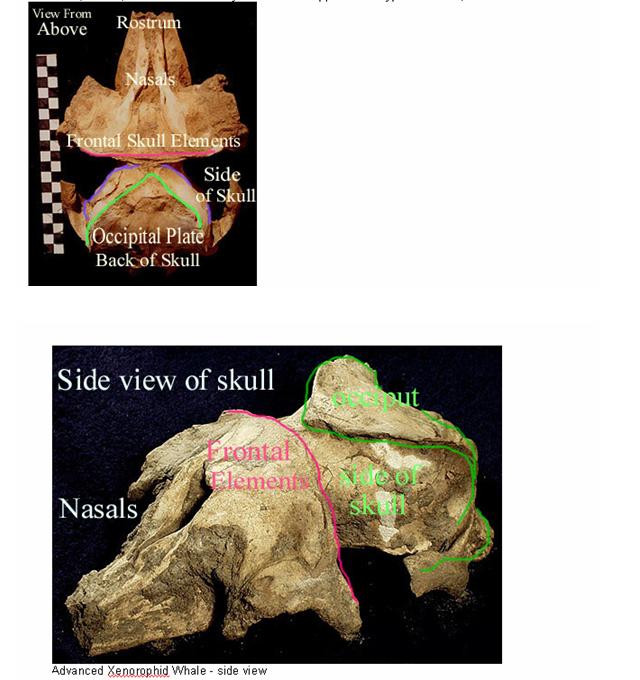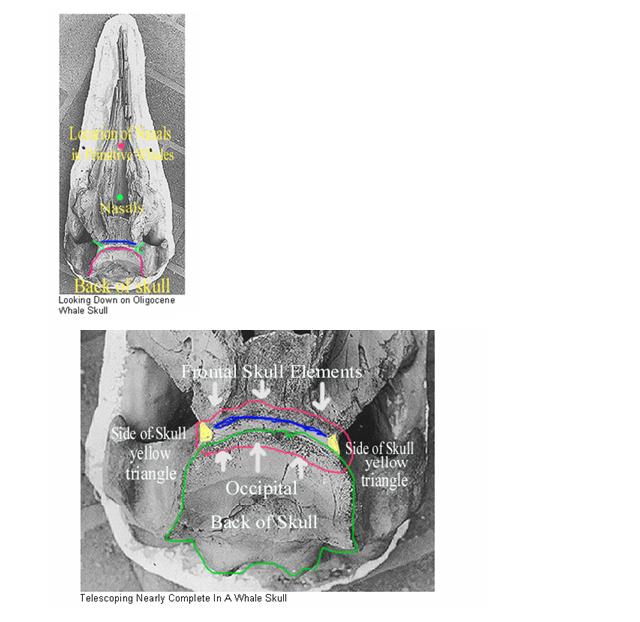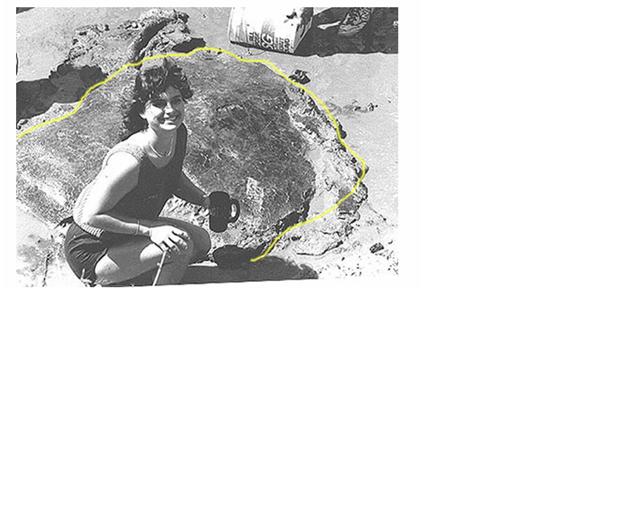|
OLIGOCENE WHALES
Sf mystery (author )
1A - My assistant holds the skull of a primitive toothed whale ( all whales were toothed to begin with ). Actually it is a prototype, for while it is easy to link it to modern whales, it is by no stretch of the imagination a true whale. Ashley Formation ( cooper xml:namespace prefix = st1 ns = "urn:schemas-microsoft-com:office:smarttags" />XML:NAMESPACE PREFIX = ST1 />Marl ). South Carolina Oligocene. It is 30 - million years old.XML:NAMESPACE PREFIX = O />
1B This proto-whale is primitive because its skull is essentially that of a land animal. It is heterodont, meaning that it has canines, pre - molars, and molars. Modern toothed whales only have canine - like teeth. The sides of the skull ( parietals ) are clearly in evidence. The girls hand is around them. The back of the skull ( occipital ), outlined in red, has yet to over ride the sides of the skull, hide them from view, and fuse with the skull's frontal elements, outlined in green, bringing the blowhole ( nasals ), on top of the head.

2 Depicted here is a molar tooth obtained from the primitive skull my assistant was holding in the previous frame. It is double - rooted, and similar in many respects to the same tooth found in Eocene archaocetes. Archaeocetes may well be the common ancestors of all toothed and mysticete species that arose during the Oligocene and which still exist today

3A This is a primitive Oligocene mysticete. It is a baleen whale. About 5 of these have been recovered from the Ashley Marl of South Carolina. Some have teeth, some have very few teeth, and the one I stumbled over had no teeth at all, though it was a young adult. These 5 specimens are very close to the ancestral species. It is primitive because telescoping ( fusing of the rear and frontal elements of the skull covering the sides of the skull ) has not proceeded very far. Consequently, the nasals are situated well down on the snout, or rostrum, not on top of his head.
3B Pictured here is the completely restored xml:namespace prefix = st1 ns = "urn:schemas-microsoft-com:office:smarttags" />7 foot long skull of the Oligocene mysticete discussed in the last frame. The rest of the skeleton is not shown. My hand, upper right, indicates skull size. This animal, a new genus, was discovered in Oligocene marine sediments. The Oligocene follows the Eocene, an epoch containing fossils about 45 - million years old.

4 Depicted here is the heterodont dentition seen in all early prototypes of the modern toothed whale. It is important to remember that these creatures were all striving to adapt to myriad ecological niches once filled by marine reptiles. Evolution was not strictly linear. Species evolved in many directions over a relatively short period of time. Competition was fierce and micro environments unforgiving. Many species died out. The xenorophids were among them. I gave Dr. Luo this specimen

5A
Shown here is the skull of a more advanced xenorophid whale. Telescoping is coming right along, though the sides of the skull, outlined in blue, are still clearly in evidence. The occipal plate, outlined in green, has extended almost to the point where it is about to touch the frontal elements of the skull, the red line. Consequently, the nasals are approaching thier modern day position atop the head. During the Oligocene, Miocene, and to some extent, the Pliocene epochs, new genera and species at different evolutionary stages appeared seemingly as fast as new cars, SUV's, and trucks do today. When this happens to a type of animal, it is called a radiation.
5B
Depicted here is a side view of the skull discussed in the preceeding frame. The tip of the lance head - like occiput approaches the red line marking the frontal elements of the skull. The sides of the skull can be clearly seen. This is a tiny skull only 10 inches long. It would have been slightly longer had the rostrum remained intact. The animal was an adult xenorophid.

6A Pictured here is an advanced new Oligocene genus. It is primitive in that the skull is symetrical and the dentition heterodont. The animal's ears did not approach the degree of specialization seen in Miocene, Pliocene, Pleistocene, and recent whales. But, telescoping is nearing completion, The sides of the skull are visible only as small triangles ( green ). Only a narrow band separates the back of the skull ( occiput), from the front of the skull. The Nasals have moved back from their former location in other, more primitive species.
6B closer view of the top of the skull shown in the preceeding photograph illustrating near completion of the telescoping process. Yellow triangles mark the sides of the skull ( parietals ).

7 depicted is the underside of the skull discussed in the last two frames. Holes seen along the margins of the rostrum or snout accomodate the roots of teeth. They are paired, so it could be ascertained that the molars and pre - molars were double rooted even if the teeth were not present to prove it. Canines typical of modern toothed whales are single rooted.

Betsey Davidson, my assistant, helps excavate an ancestor of the modern leatherback turtle.It turned out to be as large as a Volkswagon and took the crew of the submarine Lewis and Clark, Navy engineers, WESVACO Corporation, and recruits from two schools to recover in a 6 ton block. Ashley Formation ( Oligocene ). Exposed shell is outlined in yellow.

|

